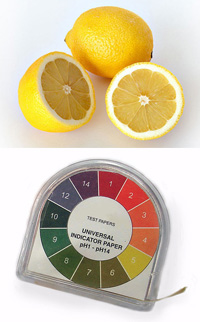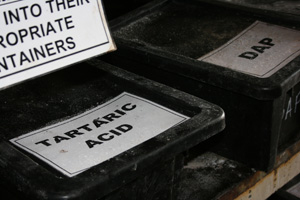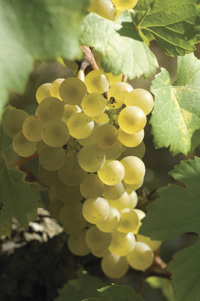Jefford on Monday
There is, surely, no topic of more compelling interest in wine chemistry than the question of acidity. There is, furthermore, no more vexed topic in wine aesthetics than the role of acidity. For these reasons, I hope a suitably qualified author (like the open-minded and thoughtful Jamie Goode) devotes an entire book to the subject one day.
Let’s start with what even simpletons like me can understand. All wines, even ‘low-acid’ wines, are acidic. In other words, these liquids have a pH of less than 7. In almost every case, the pH is somewhere between 3 and 4. (A pH of less than 3 flirts with unpalatability, though such wines can be counterbalanced with sweetness; a pH of 4 or more will usually mean a wine is microbiologically unstable.)

*credit see below.
So much for simplicity. Dipping a pH meter into a wine is only one way of measuring acidity; it can also be measured as ‘total acidity’ or ‘titratable acidity’. Though both are customarily abbreviated to TA, they are not synonymous; titratable acidity (easier to measure) is always lower than total acidity. ‘TA’ furthermore varies depending on whether it is expressed as sulphuric acid (as often in France) or tartaric acid (as mostly elsewhere); you need to multiply the former by 1.53 to calibrate it to the latter. Titratable acidity, moreover, is measured to a specified endpoint, and the result varies depending on the endpoint chosen. ‘TA’ figures, thus, are hazardous, but in my experience are in fact a much more useful guide to perceived acidity in wine than is pH. The ‘TA’ of most white wines (expressed as tartaric acid) varies from under 4 g/l for some Rhône whites to over 15 g/l in the case of some ice wines; red wines generally sit somewhere between 4 g/l and 7 g/l.
There is, though, a huge family of acids within finished wines. Tartaric, malic and citric are the main acids in juice; acetic, butyric, lactic and succinic acids are created during winemaking processes; and some of these and other acids are added as winemaking adjuncts. These, though, are just the primary acids; many more are present in smaller or tiny quantities. Tiny, but not insignificant: acids fight far above their weight in flavour terms.

© Andrew Jefford
Think about the taste of cola, tamarind, lemon and rhubarb, and in part you are thinking about the taste of phosphoric acid, of tartaric acid, of citric acid and of oxalic acid. With wine, multiply the complexity of the acid spectrum a hundredfold. Nothing exasperates me more in wine discourse than a blandly approving reference to a wine’s ‘acidity’, since 25 years of tasting have taught me that there are almost as many different acid presences as there are wines. We know so little about the subject, though, that it’s hard to say more.
As you see, we’ve reached aesthetics. One of the biggest myths of wine aesthetics is that wines “need acidity to age well”; even a short survey of great Bordeaux vintages will show that this isn’t true at all. Nor is acidity (as many allege) the most important structuring element in a wine. Acidity in itself is neither good nor bad; it is, rather, one of a number of leading elements which may structure a wine. There are great wines with prominent acidity, but there are also great wines in which the acidity is almost imperceptible. This is phenomenon of terroir (exactly how a given variety reaches ripeness in a particular site), and it is why acid-adjustment effaces or erases the sense of terroir in a wine.

© BIVB
The two most important aspects of a wine’s acidity, it seems to me, are the manner in which that acidity is bonded and integrated into the fruit presence of a wine (that fruit presence itself often in turn having an aromatic trace); and how ‘ripe’ the acidity itself seems to taste. Could this be accounted for by chemical analysis? Somehow I doubt it, but in my tasting book these qualities are deeply significant to the aesthetic success of a wine, and to how drinkable a wine proves to be.
It is also why one wine can often taste more acidic than another with an identical TA. The ‘acid wine’ often seems to have badly fruit-bonded or inadequately ripened acidity. In a successful wine, the acidity melts into and amplifies the fruit presence. (This is particularly true of red wines, so I am not referring to percentages of malic or tartaric acid; it’s more complex than that.)
I’ve also noticed that human palates vary to an astonishing degree in their receptiveness to, and liking of, acidity in wine. Burgundy palates (to simplify) relish acidity but are suspicious of tannin; Bordeaux palates take the opposite tack.
I’d even risk alleging that it’s not inappropriate to speak of a ‘national palate’ in this regard. The German and Australian palates seem to crave acidity; French, Spanish, Portuguese and North and South American palates are less acid-loving; while the Italian palate sits somewhere in the centre ground, as perhaps do the Austrian, New Zealand and South African palates. This explains a lot about the style of wines produced in each place (that which ‘tastes right’ to winemakers and the drinking public), and it is also reflected in the judgments of critics from each culture. James Halliday in Australia, for example, relishes and praises high acidity in red wines; American Robert Parker does the same for low acidity in red wines.
Next time you taste a glass of wine, in sum, don’t just gauge ‘its acidity’. Look behind and beyond.
*Image credit: Lemon (up) by André Karwath and adopted under Creative Commons Attribution-Share Alike 2.5 Generic license; Image (down):Universal indicator paper by Bordercolliez

Columnist Introduction
Andrew Jefford is a columnist for both Decanter magazine and www.decanter.com, Jefford has been writing and broadcasting about wine (as well as food, whisky, travel and perfume) since the 1980s, winning many awards – the latest for his work as a columnist. After 15 months as a senior research fellow at Adelaide University between 2009 and 2010, Andrew is currently writing a book on Australia's wine landscape and terroirs. He lives in the Languedoc, on the frontier between the Grès de Montpellier and Pic St Loup zones.
Click here to read all articles by Andrew Jefford>>
- Follow us on Weibo@Decanter醇鉴 and Facebook
and Facebook for the latest news and updates -
for the latest news and updates -
All rights reserved by Future plc. No part of this publication may be reproduced, distributed or transmitted in any form or by any means without the prior written permission of Decanter.
Only Official Media Partners (see About us) of DecanterChina.com may republish part of the content from the site without prior permission under strict Terms & Conditions. Contact china@decanter.com to learn about how to become an Official Media Partner of DecanterChina.com.

Comments
Submit